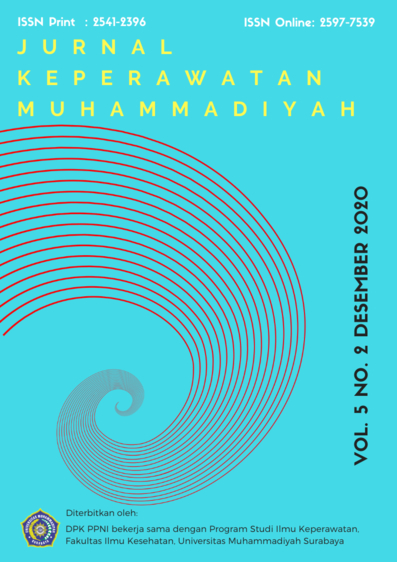Optimalisasi Program Continuing Professional Development (CPD) Untuk Mendukung Peningkatan Kompetensi dan Karir Perawat RSI Surabaya
DOI:
https://doi.org/10.30651/jkm.v5i2.6118Keywords:
CPD, Competence, Career Path, NursingAbstract
Nurses are an integral part of patient care and play an important role in improving the quality of care in the hospital. Nurses have a responsibility to ensure patient safety with reliable and guaranteed competence. Nurse competence must be maintained through continuous professional development. The purpose of this study was to map the level of participation, driving and inhibiting factors for the implementation of the Continuing Professional Development (CPD) program. This study used a cross-sectional study design with a quantitative descriptive approach. The study population was all RSI nurses with a total sample of 104 survey participants with purposive sampling technique. Data were collected using an online questionnaire through the google form application from June to September 2020. Data analysis was carried out through SPPS 17 and presented in descriptive and tabulated narrative. The results of the study were the level of participation of nurses at the Surabaya Islamic Hospital in carrying out CPD activities which were divided into 3 categories, namely high, medium and low participation. A total of (17.3%) belonged to the low level of participation, (69.2%) the level of participation was medium and (13.5%) was classified as high. Some of the nurses in this survey reported reaching structural and clinical positions of nurses quickly through the skills, approaches and recommendations of managers. Short-term development plans are a priority for nurses' thinking in improving (CPD), namely the continuous fulfillment of complete nursing care practices and increasing the clinical career level. The long-term development plan for nurses is that some want to continue educational programs at a higher level such as specialized education and master's degree in nursing.
References
Akbari, M., Bagheri, A., Fathollahi, A., & Darvish, M. (2020). Job satisfaction among nurses in Iran : does gender. Journal of Multidisciplinary Healthcare, 13(71–78), 71–78.
Brekelmans, G., Poell, R. F., Wijk, K. Van, & Brekelmans, G. (2013). Factors influencing continuing professional development A Delphi study among nursing experts. European Journal of Training and Development, 37(3), 313–325. https://doi.org/10.1108/03090591311312769
CM Fahey, J. M. (2005). Australian rural midwives : perspectives on continuing profesional development. The International Electronic Journal of Rural and Remote Helath Research, Education, Practice and Policy.
Coventry, T. H., Maslin-prothero, S. E., & Smith, G. (2015). Organizational impact of nurse supply and workload on nurses continuing professional development opportunities : an integrative review. Journal of Advanced Nursing, 71(12), 2715–2727. https://doi.org/10.1111/jan.12724
Department of Health South Australian. (2014). Nursing and Midwifery Capability Department of Health South Australian.
Hariyati, R. T. S., Igarashi, K., Fujinami, Y.,
Susilaningsih, F. S., & Prayenti. (2017). Correlation between Career Ladder, Continuing Professional Development and Nurse Satisfaction: A Case Study in Indonesia. Journal of Nursing Management, 10(nursing career), 1–3.
Hemmington, N. (2000). Barriers and drivers to continuing professional development: The case of the hospitality industry. Continuing Professional Development, 3, 23–32.
Johnson, A., Hong, H., Groth, M., & Parker, S. K. (2010). Learning and development: promoting nurses’ performance and work attitudes. Journal of Advanced Nursing, 67(3), 609–620. https://doi.org/10.1111/j.1365-2648.2010.05487.x
Joyce, P. (2007). Continuing professional development : investment or expectation ? Journal of Nursing Management, 15, 626–633.
Kementrian Kesehatan RI. (2014). UU No.38 Tahun 2014 Tentang Keperawatan. Jakarta: Sekretariat Negara.
Kiriaki, T., Olga, Z., Christos, I., Aikaterini, F., & Lambrini, K. (2020). Factors Affecting Nurses Lifelong Learning. Sanitas Magisterium, 1–9.
Kivinen, J. L. T. (2012). Continuing professional development in nursing: does age matter? Journal of Workplace Learning Continuing, 24(1), 34–47.
Macaden, L., Washington, M., Smith, A., Thooya, V., Selvam, S. P., George, N., & Mony, P. K. (2017). Continuing Professional Development : Needs , Facilitators and Barriers of Registered Nurses in India in Rural and Remote Settings : Findings from a Cross Sectional Survey. Open Journal of Nursing, 271, 930–948. https://doi.org/10.4236/ojn.2017.78069
Muhadi. (2019). Laporan Hasil Penelitian: Analsisi Kebutuhan Pelatihan Perawat. Surabaya.
Pool, I. A., Poell, R. F., & Berings, M. G. M. C. (2015). International Journal of Nursing Studies Strategies for continuing professional development among younger , middle-aged , and older nurses : A biographical approach. International Journal of Nursing Studies, 52(5), 939–950. https://doi.org/10.1016/j.ijnurstu.2015.02.004
Pool, I. A., Poell, R. F., Berings, M. G. M. C., & Ten Cate, O. (2015). Strategies for continuing professional development among younger, middle-aged, and older nurses: A biographical approach. International Journal of Nursing Studies, 52(5), 939–950. https://doi.org/10.1016/j.ijnurstu.2015.02.004
Price, S., & Reichert, C. (2017). administrative sciences The Importance of Continuing Professional Development to Career Satisfaction and Patient Care : Meeting the Needs of Novice to Mid- to Late-Career Nurses throughout Their Career Span. Administrative Sciences, 17(7), 41–52. https://doi.org/10.3390/admsci7020017
Rn, Y. K., Mn, S. F. Y., Rn, S. M., & Rn, M. S. N. (2018). Investigating nurses ’ quality of life and work- life balance statuses in Singapore. International Nursing Review, 1–9. https://doi.org/10.1111/inr.12457
Ross, K., Barr, J., & Stevens, J. (2013). Mandatory continuing professional development requirements : what does this mean for Australian nurses. BMC Nursing, 12(9), 1472–6955. https://doi.org/https://doi.org/10.1186/1472-6955-12-9.
Rumah Sakit Islam Surabaya. (2018). Laporan Seksi Diklat RSI Ahmad Yani Surabaya. Surabaya.
Skår, R. (2010). How Nurses Experience Their Work as a Learning Environment. Vocations and Learning, 3, 1–18. https://doi.org/10.1007/s12186-009-9026-5
Tiwari, R. (2012). Situational analysis of nursing education and work force in India. Nurs Outlook, (October 2017), 129–136. https://doi.org/10.1016/j.outlook.2012.07.012.
Downloads
Published
Issue
Section
License
- Penulis tetap memegang hak atas karyanya dan memberikan hak publikasi pertama kepada jurnal ini yang secara simultan karya tersebut dilisensikan di bawah:Â Creative Commons Attribution-ShareAlike 4.0 International (CC BY-SA 4.0)













